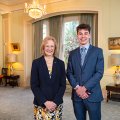.jpg?itok=7hoo-aBB)
Formal academic headwear will be flung high during the coming week of graduations at The University of Queensland.
For the first time, UQ’s official supplier of academic regalia will allow the vast majority of graduates to keep their mortarboards, the traditional flat-topped head dress also known as the trencher.
Academic Services Division manager Athol Reid said the arrangement between UQ and Reed Graduation Services, meant coursework graduates could keep their trenchers as a graduation gift.
“Previously the caps were only for hire,” he said.
“Graduands who hire through the official supplier can keep the cap, which will have a commemorative label and UQ insignia inside.
“We’re expecting some lovely photos as students throw their trenchers in the air as they do at American universities and in the movies.”
Of course students wanting to throw trenchers need to take care and to avoid enclosed spaces.
“The tassels are soft but the caps have hard corners, so you don’t want to hit anyone,” Mr Reid said.
He said doctoral graduates would still need to return their hire bonnets.
Graduating students can order their academic dress online at Reed Graduation Services or on-campus from 11 December. Further information is on the UQ graduations website.
Graduations run from Friday 11 December to Saturday 19 December, at the University’s St Lucia and Gatton campuses.
Students can receive their degrees without attending a ceremony, but most choose to attend.
About 5500 of the estimated 7500 students graduating from UQ this month are expected to attend ceremonies.
UQ Vice-Chancellor and President Professor Peter Høj said each student graduating from UQ was gaining a qualification from a world-class university.
“UQ is consistently well inside the world’s top 100 in all major university rankings, and two of these currently place UQ in the world’s top 50,” Professor Høj said.
UQ is 45th on the Performance Ranking of Scientific Papers for World Universities, 46th on the QS World University Rankings, 52nd on the US News Best Global Universities ranking, 60th on the Times Higher Education ranking, and 77th on the Academic Ranking of World Universities.
“UQ attracts students, lecturers, researchers and business partners from around the globe, and the University’s high reputation stands our graduates in good stead as they enter the global job market,” Professor Høj said.
“Disruptive technologies have swept through entire industries, but our graduates are well placed to embrace new opportunities, to be part of transforming economies and to create change rather than be swept aside by it.”
Professor Høj said the December graduates would join UQ’s 232,000-strong alumni group – including more than 12,000 PhDs – in at least 170 countries.
They included leading melanoma researcher Professor Adéle Green, Queensland Premier Annastacia Palaszczuk, actor Geoffrey Rush and Nanopatch needle-free vaccine delivery device inventor Professor Mark Kendall.
“UQ’s alumni group includes many outstanding leaders in government, industry, research and not-for-profit organisations in Australia and internationally, and I look forward to hearing of the successes of this graduating group in years to come,” Professor Høj said.
Professor Høj said people who wanted to study at UQ in 2016 should apply through the Queensland Tertiary Admissions Centre.
Prospective students can see key dates for QTAC applications and offer rounds here.
They can also contact UQ Admissions on (07) 3365 2203 or admissionsenquiries@uq.edu.au for information.
Instagram photos hashtagged #UQmemories or #UQalumni will be added to UQ’s December graduation collection.
Media: UQ Communications, communications@uq.edu.au, 07 3346 0561.
Background: Academic dress
The ceremonial gowns, hoods and caps worn at UQ and other universities evolved from Europe’s first universities in the 12th Century. Masters and scholars at the time were usually clergy, and early academic dress reflected clerical garb.
A century later, the Church adopted the pileus, a commonly worn medieval head-dress, and it became typical university head-wear. One variation, the pileus quadratus (square cap), developed into today’s trencher (or mortar board) worn by most degree candidates. The velvet bonnet worn by doctoral candidates is an example of lay fashion in 15th Century France.
The tradition of throwing graduation caps in the air is understood to stem from the US Naval Academy in 1912. That year the Navy gave its newly appointed graduates their officers’ hats at graduation. This meant they no longer needed the midshipmen’s caps they had worn for four years, so they made a spectacle of joyfully tossing them skyward.
.jpg)








